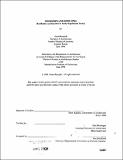Modernism and dwelling : residential architecture in early republican Turkey
Author(s)
Kanipak, Omer, 1972-
DownloadFull printable version (61.42Mb)
Advisor
Sibel Bozdogan.
Terms of use
Metadata
Show full item recordAbstract
The entire cultural and social context of the 1930s' Turkey was heavily influenced by the modernization reforms and the official ideologies of the Republican regime. By these reforms, Kemalist regime aimed to transform the whole society and its cultural production. While the existing transformations in the social context was already on their way to Westernization, they were appropriated and accelerated by the Republican modernization reforms. On the other hand, architectural discourse experienced more radical and abrupt transformations when modern architecture was introduced into the architectural culture: Although precedents of modern architecture existed in the pre-Republican period, the official Republican ideology incited the introduction of modern architecture into Turkey. Despite the exceptional importance given to the architectural field, usually it was the foreign architects who got the large scale commissions. This discrimination eventually created a discomfort among Turkish architects. Consequently, Turkish architects who were enthusiastic to produce modern architectural examples had been compelled to operate in the domain of residential architecture. Hence, 1930s' architectural culture experienced the intricate amalgamation formed by the interaction of contradictory ideologies such as dwelling, modernism and nationalism. In addition to the brief analyses made on the Istanbul households and the architectural discourse of the 1930s, the main aim of this study lies in the close formal readings of the residential examples built in Istanbul between the years 1931 and 1940. In this section, I focused on some of the recurrent formal features of these buildings. By analyzing the cultural and ideological significance of these recurrent architectural features, I avoided the architectural examples to determine the framework of my study with their seemingly coherent images. Hence, it became possible to analyze the constitutive gestures of this architectural culture without being influenced by the larger collective images of the buildings. The analyses on the social and symbolic functions of these recurrent features help us to understand the unique characteristics of the architectural culture of the early Republican period.
Description
Thesis (M.S.)--Massachusetts Institute of Technology, Dept. of Architecture, 1998. Includes bibliographical references (leaves 214-219).
Date issued
1998Department
Massachusetts Institute of Technology. Department of ArchitecturePublisher
Massachusetts Institute of Technology
Keywords
Architecture